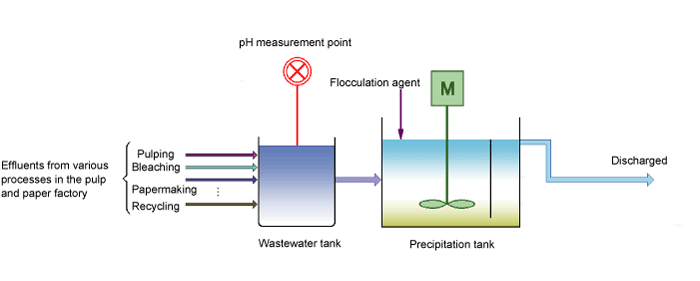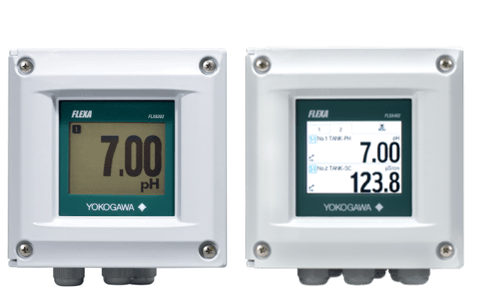Effective pH Measurement System of Wastewater Treatment
Industry: Pulp and Paper
Product: pH Process Liquid Analyzers
Introduction
Pulp and paper plants consume large volumes of water, and the treatment of wastewater from these plants is a serious environmental concern. To treat the wastewater, suspended solids are separated and precipitated in a precipitation tank using flocculation agents. During this process, the pH must be maintained at the proper level, the status of which is controlled by referring to a pH analyzer. In the past, pH analyzers needed to be cleaned frequently as fibers and coating agents in the wastewater adhered to the electrodes.
Yokogawa tested a submersion-type holder with a cleaner to determine its effectiveness in the continuous cleaning of pH analyzers. Manual maintenance of pH analyzers used to be conducted daily, but the test results have demonstrated that this submersion type holder can reduce the manual cleaning frequency to just once every one-to-two months.

Process Overview
Wastewater at pulp and paper plants contains effluents from the pulping, bleaching, papermaking, and recycling processes. The treatment of this wastewater involves pH level control, solid-liquid separation, oxidization, and other processes. It depends on such factors as the levels of organic, reducible, and suspended matter in the wastewater as well as its chromaticity. For example, most suspended solids are fine substances that do not precipitate easily, so they are removed by applying flocculating agents, which produce a chemical reaction. To detect the endpoints of these chemical reactions and to manage and control the precipitation tank, the pH of the wastewater tank is measured.
Typical problems
- Coating on the sensor
Remedies
- Frequent sensor cleaning
Tangible benefits
- Save downtime in cleaning and repeated calibration; improve end-product quality.
Product Recommendations
Measurement System
Process Liquid Analyzer:
- 2-wire FLEXA pH/ORP Analyzer
- 4-wire FLXA402 pH/ORP Analyzer

Features
- Dual sensor measurement on 2-wire type analyzer and up to five sensor measurements on 4-wire type analyzer.
- Indication of sensor health status
- Easy touchscreen operation
- Trending display up to two weeks
- Advanced process temperature compensation
Sensor Selection:
FU20 with “/HCNF” with Cleaning reagent
Recommended Installation – using immersion fitting

Digital SMART Option:
The reusable smart adapter, SA11, offers the full measuring parameter functionality of analog sensors equipped with a Variopin connector and Yokogawa ID chip. The SA11 automatically recognizes the installed sensor and prepares the appropriate configuration.

Features:
- Long-life saturated Ag/AgCl reference system.
- PTFE reference diaphragm to prevent fouling and reduce measurement error.
- Double junction combined with ion-trap to prolong the life of the reference probe even in chemically unfavorable environments.
- Polymerized electrolyte to extend the sensor lifetime.
The /HCNF option comes with a Hastelloy cleaning nozzle, stainless steel mounting and ferrules sets, and a nylon tube of 10 meters.
Conditions
- Effectiveness of previous cleaning methods: Cleaning methods using a standard jet cleaner and a brush were tested. Fibers in the effluents that had attached to the electrode could not be removed using either of these cleaning methods. (Both types of cleaning operations also had to be suspended once a day to conduct manual cleaning of the electrode.)
- Effectiveness of continuous cleaning: The amount of the contaminants on the electrode decreased significantly. Manual cleaning and calibration were found to be required just once every one or two months.
Industrias
-
Papel y pulpa
La industria del papel y la pulpa es altamente competitiva y debe satisfacer necesidades del mercado que están en constante cambio. Yokogawa ayuda a poner en operación plantas eficientes en el consumo de energía que son sostenibles globalmente.
Productos y Soluciones Relacionadas
-
Digital SMART SENCOM™ Adapter, SA11
Reusable SMART adapter, requiring only the analog sensor to be disposed of when it reaches the end of its lifetime. With the SENCOM 4.0 platform, Yokogawa delivers reduced costs and waste while contributing to its long-term business goals of a sustainable future for all.
¿Tiene Dudas?
Contacte a un Experto de Yokogawa y conozca como podemos ayudarle a resolver sus retos.